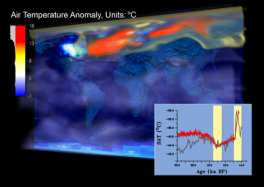Overview
The Earth System Modeling (ESM) Group is interested in the understanding and projection of the global climate system and its interaction with the earth’s environment. Led by the Max Thomas Professor of climate dynamics, Zhengyu Liu, the ESM group performs simulations of past, present and future global climate change using state-of-the-art earth system computer models. These models consist of interactive components of the atmosphere, ocean, land, and sea ice, as well as terrestrial environment and marine biogeochemical cycles.

Over its history, Earth’s climate system has undergone dramatic changes, from hot, greenhouse worlds to glacial-interglacial cycles. At present, global climate and our society are also experiencing large changes from year to year and from decade to decade due to prominent climate variability modes, notably El Nino and Southern Oscillation, Atlantic Multidecadal Variability and Pacific Decadal Oscillation. Increasing emissions of greenhouse gases due to human activity and its impact on the Earth’s climate is one of the most challenging issues facing our society in the coming century. The ESM Group studies a wide range of climate phenomena from global to regional scales, such as global temperature and precipitation, monsoon systems and Atlantic Meridional Overturning Circulation. This group tests earth system models against past and present observations and then uses these models to improve projections of future climate change.

